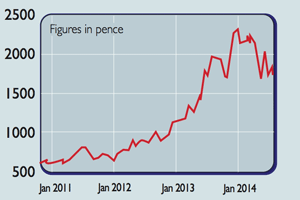Gamble of the week: This fashion retailer isn't cheap - but it is worth it
Paying too much for a share is a good way to lose money, says Phil Oakley. But this fashion house could be an exception.
Founded back in 1987, selling shirts in Glasgow, this fashion stock has proven itself to be a very good business. To say it is a gamble might imply that it is a risky business. But it isn't really, or at least no more than most international retailers.
What has made it a bit risky for investors is that its share price has been a bit frothy paying too much for a share can often be a very good way to lose money. It's also quite an illiquid share which means its price can move quite sharply, even when very few shares are traded.
The shares were changing hands for nearly £24 at the beginning of March, but they're now just over £17. They are still highly rated at just over 20 times this year's forecast earnings but the company's potential to keep profits growing means the shares have become interesting once again.
MoneyWeek
Subscribe to MoneyWeek today and get your first six magazine issues absolutely FREE

Sign up to Money Morning
Don't miss the latest investment and personal finances news, market analysis, plus money-saving tips with our free twice-daily newsletter
Don't miss the latest investment and personal finances news, market analysis, plus money-saving tips with our free twice-daily newsletter
Ted Baker (LSE: TED)wants to become a prominent lifestyle fashion brand. But unlike other companies trying to do the same thing, Ted Baker is doing something different. It's not selling expensive handbags but is focusing on selling good quality stuff at a fair price, or "affordable luxury" as it is known. And, so far, it's been very successful at doing this.
Not only that, but Ted Baker has, so far, been good at mining different ways of selling its products. It has high street stores and concessions in department stores and an internet business.

The company has been very good at notexpanding its business too quickly, orinto the wrong countries. This is shownby the fact that it has been able to growits sales at a faster rate than the increasein selling space a sure sign of a verygood retailer.
Profitability is very good too, and thereturn on shareholders' equity was avery impressive 25.7% last year.Current trading continues to be verystrong, with very strong sales growthshowing across all its selling channels.
Analysts are forecasting that earningsper share will increase by nearly aquarter this year and by a double-digitpercentage in 2016.When it comes to shopping and buyingshares, most of us will admit that we likea bargain. Sometimes though, it's worthpaying up for a quality business andthen hanging on to it.
Verdict: buy
Get the latest financial news, insights and expert analysis from our award-winning MoneyWeek team, to help you understand what really matters when it comes to your finances.
Phil spent 13 years as an investment analyst for both stockbroking and fund management companies.
After graduating with a MSc in International Banking, Economics & Finance from Liverpool Business School in 1996, Phil went to work for BWD Rensburg, a Liverpool based investment manager. In 2001, he joined ABN AMRO as a transport analyst. After a brief spell as a food retail analyst, he spent five years with ABN's very successful UK Smaller Companies team where he covered engineering, transport and support services stocks.
In 2007, Phil joined Halbis Capital Management as a European equities analyst. He began writing for MoneyWeek in 2010.
-
 The graphene revolution is progressing slowly but surely
The graphene revolution is progressing slowly but surelyEnthusiasts thought the discovery that graphene, a form of carbon, could be extracted from graphite would change the world. They might've been early, not wrong.
-
 How Javier Milei led an economic revolution in Argentina
How Javier Milei led an economic revolution in ArgentinaFollowing several setbacks, Argentine president Javier Milei's pro-market reforms have been widely endorsed in a national poll. Britain will need the same